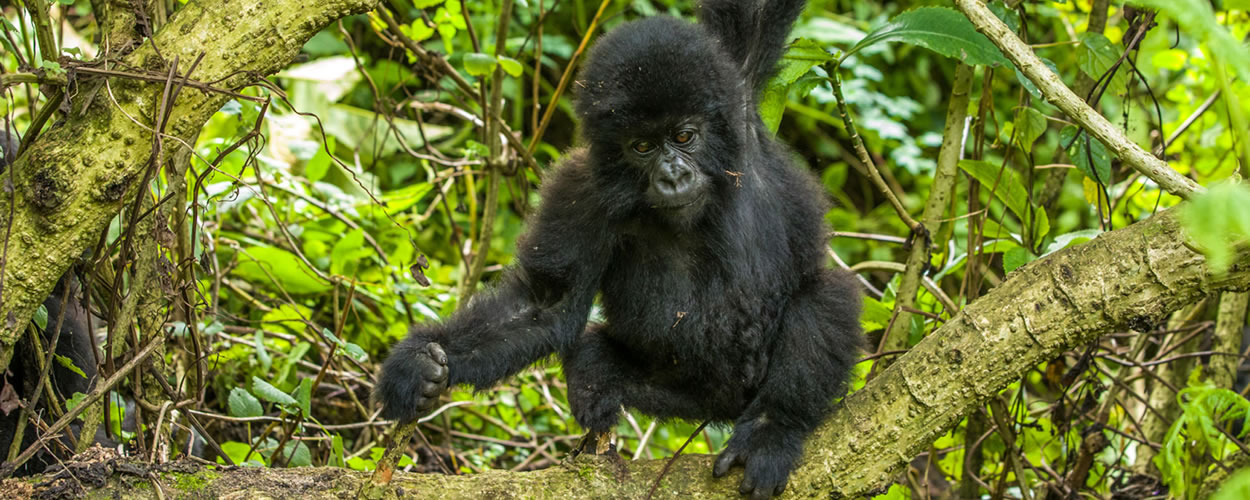There is much more to the ‘the country of a thousand hills’ than initially meets the eye. Small, compact and easy to travel around, friendly Rwanda has well and truly consigned the tragic genocide of 1994 to history. The country has reconciled and rebounded spectacularly from this tragedy and today it is one of the friendliest, safest and most welcoming countries on the continent. We at gorilla safaris tours are ready to take you around and offer you the best gorilla tours in either Volcanoes or Mgahinga Gorilla National Park and the two forms the Virunga massifs.
Below are the key attractions to see and do on Rwanda Tour:
Volcanoes National Park
In Volcanoes National Park we have gorillas and monkeys’ treks. The gorilla trekking tours are phenomenal! Group size is limited to 8 and they strictly limit total to under 100 to minimize stress on gorilla family. They have extensive tracking and scout programs to know where family is settling for the day. Safety is thorough and protection of ape’s paramount.
There is a striking visible line you cross when you hike through some agriculture patches to the border of the park. It is amazingly clean. It is rain forest so dress and act accordingly. The volcanoes and their history are visible and well guided. You realize the vastness and understand the Rwanda side can be very different from the Congo side. This is a story of very insightful people preserving an area before shortsighted people wiped it out. A victory of preservation especially for mountain gorillas and the golden monies.
The Volcanoes National Park is simply awesome. You shouldn’t miss it if you come to Rwanda for a few days or for several years. As far as I am concerned, hiking volcanoes is another activity to undertake in this park. It’s a terrific activity, in a well-preserved nature.
There are 5 volcanoes you can hike in that park: Mount Gahinga, 3,474 m, ideal for a first hike; Mount Muhavura, 4,127 m, the most challenging one (and my favorite!); Mount Bisoke, 3,711 m, the most popular (there is a scenic crater lake at the top); Mount Sabyinyo, 3,669 m, the most forested one (several people have spotted gorillas and other animals on this hike); and last but not least, Mount Karisimbi, 4,507 m, the highest one, the roof of Rwanda, with a layer of snow at the very top, during the rainy season. You can get a permit and a guide to climb them at the RDB, in Kigali, or at the Volcanoes National Park headquarters in Ruhengeri.
Akagera National Park
Akagera is the only protected area offering traditional Big Five safaris in Rwanda. It boasts good wildlife opportunities, although not on quite the same scale as other iconic East African parks. Unlike the densely forested protected areas elsewhere in the country, Akagera is a typical Savannah park dominated by grasslands and broken woodland. It is a refuge for elephant, buffalo, giraffe, tsessebe, impala and Defassa water buck, while large populations of hippo and the elusive sitatungas, a rare aquatic antelope that thrive in the well-watered eastern sector of the reserve.
Apart from the large Akagera Game Lodge near the entrance, several tented camps deeper in the park offer more of a bush experience. Magashi Camp in the northeastern corner of the park operates on a private concession, and a stay here is on a par with what you can expect in the top private game reserves in southern Africa. You can find the game viewing overall more rewarding in the north of the park. So, if you are staying in the south, it is worth taking a packed lunch and heading north for a full-day game drive.
Nyungwe Forest National Park
Nyungwe Forest is a very beautiful place indeed. It is easily accessed from a good tarmac road, with a range of accommodation options and a well-organized park headquarters. Most tourists come to track chimpanzees and you need to book your permit in advance. The habituated chimpanzees are in a patch of forest away from the main area so you need transport. Do hire a porter. They carry your bag, and more importantly, help you navigate or rather haul you up and down the steep slopes as you try to follow the rapidly moving chimps.
Nyungwe is also home to eight species of monkey, some of which are quite easy to see on the road and from the trails you can also arrange to visit the delightful habituated black-and-white Colobus troop.
Nyungwe is a mecca for bird-watchers with 27 Albertine Rift endemics. There are specialist bird guides at the park headquarters, but forest bird watching can be difficult and frustrating. In addition, the park has wonderful trails and waterfalls, not to mention an aerial boardwalk, so it is well worth spending at least two or three nights here.
Lake Kivu
Lake Kivu is one of the Great African Lakes that lies on the border between the Democratic Republic of Congo and Rwanda. It is part of the Albertine Rift. Lake Kivu provides its water to the great Ruzizi River that flows southwards into Lake Tanganyika. It has a surface area of 2,700 sq. km, with a maximum width of 48 km and a length of 89 km. It is a lifeline of Gisenyi town.
On the Rwandese side, the lake forms many spectacular sandy beaches. Rubavu Public Beach is one of the most famous ones among others. It is an interesting trip, boat riding on Lake Kivu, and enjoying interesting stories about the lake and its islands.

